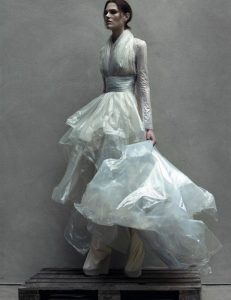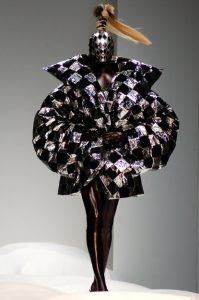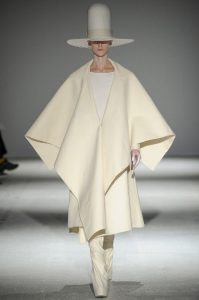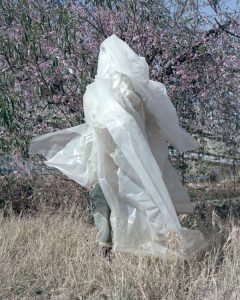Fashion Designer – Gareth Pugh
Reference Mood Board
Image analysis
“Gift 2013” from the collection “Terrain”
Photographer: Jackie Nickerson
Shoot location: Southern Africa
The subject of the shoot is a local farmer from Southern Africa who has been immersed in a piece of plastic sheeting to obscure their face and body. The portrait image is a head on shot of the subject which gives it a more intense contrast between the harshness of the plastic and the softness of the natural landscape behind the subject. By having the image in full focus, the viewer can see the harsh folds and lines of the plastic more clearly which gives the image more definition and sense of 3D form. The image has been taken with most likely a DLSR camera and has been probably slightly cropped to allow a stronger point of focus on the subject to make them the focal point of the image more successfully. Nickerson has used the rule of thirds as well to immerse the viewer in the subject of the photo by positioning them in the full 3 centre segments with small pieces of plastic sheeting spreading out to then allow the viewer to observe the natural landscape surrounding the subject. The style of the image is more of an artistic portrait of the subject with them only suggested through the basic form whilst the rest is hidden through the plastic sheeting, however this in itself instigates narrative. Nickerson tends to work with the normal people of Southern Africa such as farmers and workers as the subjects of her images. The tones tend to be faded slightly and there is a common trend of obscuring the subjects face or body in some way to conceal identity. The shoots also normally take place in the landscapes these people work in.
When comparing this image to Nickerson’s other work it is clear to see that they all follow a common trend of obscurity of identity and a focus on the landscapes the subjects work and live in. After reading a review of Nickerson’s work by Jack Shianman I have been able to broaden my understanding of the work, he writes “TERRAIN is about us in the landscape, how we change the world we inhabit at every moment of our being human, and how, for better and for worse, the world that we make, in turn, changes who we are.”. This statement involves a deeper understanding of how we as humans adapt into our environments and effect it both positively and negatively in the process. Nickerson illustrates this concept within what she clads her subjects in – palm leaves, crates, plastic and tangled wood – all of which create their own contrasts and atmospheres when placed within the natural landscapes around the subjects, for example the contrast between the plastic and nature within this image is slightly strange to view and I feel like that represents the current balance between humanity and nature in that its unbalanced and not synced with one another with the plastic being harsher against the softness of the plants behind it. I decided to compare Nickerson’s work to that of Steve McCurry who does a lot of travel portraits of the local people in the places he visits, by comparing the two an interesting contrast surrounding colour was seen as McCurry’s photography was a lot more vibrant and portrayed a more colour side to life and humanity by expressing a variation of culture and what humanity is. This is different to Nickerson whose work is more faded in tone and instead of expressing the subjects face (which McCurry uses to express the life of the subject and connect with the viewer) she instead uses objects to hide them and allow the viewer to develop deeper meaning on the relationships of the elements of the image and how they compare to humanity’s relationship with the surrounding world. McCurry’s imagery also commonly uses a shallow depth of field to focus more on the subject rather than the landscape around them whereas Nickerson uses a wider depth of field to express a balance in her work and relationship in the elements.
In conclusion Nickerson’s work demonstrates a sense of opposite and an unbalanced nature which allows me to see why Pugh was influenced by it for his AW14 collection which features more stripped-down materials and materials similar to the plastic sheeting in the photographed draped onto the model’s body. Through my research into Pugh’s references I found opposites to be a key element which is most likely why he became interested in this image by Nickerson, due to its strange relationship between the subject and the landscape as there was something slightly off about it but it’s hard to describe which I feel is a common element of Pugh’s collective works.
Bibliography
http://www.dazeddigital.com/fashion/article/11272/1/20-qas-gareth-pugh
http://www.dazeddigital.com/fashion/article/23560/1/gareth-pugh-a-visual-history
http://www.dazeddigital.com/fashion/article/20252/1/gareth-pugh-s-labyrinth
http://garethpugh.blogspot.co.uk/p/collections.html
http://www.jackshainman.com/artists/jackie-nickerson/






